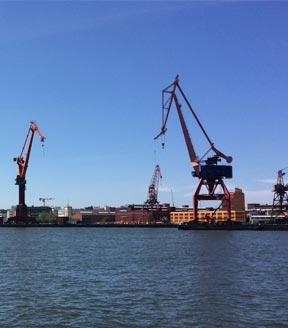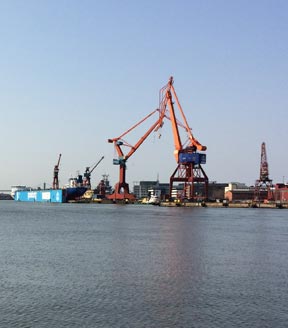The Port of Gothenburg is the largest port in the Nordic region. For many, the hallmark of the Port of Gothenburg is what we see at the Hisingsbron, Lilla Bommen and at the Stena Terminal. But the Port of Gothenburg has several different ports. In the inner city there are Frihamnen, Innehamnen Norra and Innerhamnen Södra. After the Älvsborg Bridge and out towards the Kattegatt are Skarvikshamnen, Skandihamnen, Älvsborgshamnen, Arendal and Torshamnen.
Another feature of the port in Gothenburg is the Eriksberg crane, which today stands majestically red at Eriksberg. The crane symbolizes the shipbuilding industry that characterized Gothenburg during the 1950s and 60s.
In 1875, Lindholmsdockan came to the site, which was previously a shipyard but today houses a food market - Lindholmen Street Market. Many ships were built at Lindholmen and when the yard closed down in 1976, approx. 600 ships had been built in Gothenburg.
History of the shipyards in Gothenburg
Over the years, a total of approx. 1,800 ships have been built in Gothenburg, ranging from large ton ships to smaller boats. When the icebreaker Oden left the port of Gothenburg (Arendalsvarvet) in 1988, the shipyard era with new ships in Gothenburg ended. In Gothenburg, several thousand workers had worked over the years in the port and now the shipyard period was over. Around the 1970s, there were about 200,000 people who worked in the port.
Arendalsvarvet was the last yard to close and also the last yard to open in Gothenburg. Arendalsvarvet started in 1963. The earliest shipyards in Gothenburg started in 1841 and were first called "Keillers Verkstad" but later became ""Göteborgs Mekaniska Verkstad AB" and then "Götaverken AB".
Another well-known shipyard is also "Gotenius Varv", which started in the 1950s.

When did the laps start in Gothenburg?
It all started with the Scotsman Alexander Keiller who started a small workshop on Skeppsbron in Gothenburg. The firm was named "Keiller & Co". The company worked with foundries and forges to manufacture various machines. At Keiller's company, people learned their job by being trained by those who already worked there. After 26 years, the company went bankrupt in 1867. The company is taken over by completely new owners and with a new company.
The name will be "Göteborgs Nya Verkstads AB". The number of employees around the year 1907 is approximately 625 employees. In 1917, the company changed its name to "Götaverken". The company went bankrupt in 1867. The company was taken over by completely new owners and a new company
Götaverken
Around 180 ships were built at Götaverken between 1866 and 1917. Everything from warships to tankers and pontoon cranes was built. During the First World War, times are good and an armored ship called "Sverige" and the tanker "Hamlet" of 7,000 tons are built. It is also being built if a ship at Götaverken - the Norwegian American Line's "Stavangerfjord" is being converted from coal- to oil-fired. During the 1930s, in addition to boats, they also built steam engines, bridges, windows and foundry products. it is included Airplanes are also included in the production! At the beginning of the decade, approximately 4,000 employees work at Götaverken.
During the 1950s, the shipyard flourished with the majority of boatbuilding and new technology in welding construction. In 1959, they expand their production with a new shipyard, Arendalsvarvet. During the 1970s, the business is divided into areas such as engine, repair and steam technology, but there is fierce competition in the world within the shipbuilding industry, and the state becomes the owner in 1971. In 1978, over several thousand workers are laid off at the shipyard and in 1985, the business shrinks rapidly. The definitive end of Götaverken's history is when the "floating dock" that came to the harbor from Poland in the 1970s leaves Gothenburg on May 6, 2016.
Arendalsvarvet
In 1963, Arendalsvarvet was inaugurated by Tage Erlander. Ships larger than 50,000 tons were built at the yard. Arendalsvarvet's creator was Nils Svensson. At the shipyard, new methods were used to build, which also attracted great interest abroad.
In addition to large ships, offshore products were also built for the oil industry, including oil rigs. In 1988, the icebreaker Oden left Arendalsvarvet and that delivery was the last delivery from Gothenburg in shipbuilding.

What does it look like in the port of Gothenburg today??
Today we travel to Denmark from Masthuggskajen at Järntorget. We commute daily with Älvsnabben, which departs between the center's stop - "Lilla Bommens hamn" and "Klippan's ferry stop" at Hisingen. The boat stops at several stops on both sides of the river. On the Hising side, you can walk around Eriksberg on the Norra Älvstranden. There are homes and restaurants and hotels here.
At berths in the central city centre, you can sit outside on Opera's summer veranda and look out over Bananpiren on the Hising side and look out over the harbor entrance. If you're lucky, even the Toad can pass by with his tourists. If you want to stay in a hotel in the middle of the harbor, you can spend the night on the ship Barken Viking at Lilla Bommen, which is about 10 minutes' walk from the central station. The ship has been at Läppstiftet since the 1950s.
Today, the majority of different goods are handled in the port. Several different ships come to the port with steel, paper, wood, steel and oil. Further out in the port of Gothenburg, cars are shipped to different parts of the world. About 40 million tons of goods are handled in the port every year. The port also receives ships that come with coffee, juice and fruit.
Emigration to America.
At Packhuskajen in Gothenburg, the emigrants boarded their ship which would take them to America via England. In 1915, Svenska Amerika Linien started its journeys for passengers between Gothenburg and New York. For those traveling to Gothenburg Central Station, Postgatan became the street where everything happened - here there were hotels, guesthouses, shops, restaurants. Here they waited for their boat to depart for America.
Early History Gothenburg Harbour
The port in Gothenburg existed before Gothenburg was founded in 1621. In the 18th century, iron and timber were exported from the port. The Swedish East Indian Company was formed in 1731 and traded with East Asia, mainly China. The company dissolved in 1813. During the 19th century, when the steamboats started, the first quays began to be built - Skeppsbrokajen, Packuskajen and Stenpiren. During the middle of the 19th century, the port expanded in step with industrialization. The port needed to expand during the 1960s and moved out to the outer areas of the port. Skandiahamnen was built to handle the new container traffic. Torshamnen is built to receive the large oil tankers that arrive in the city. Älvsborgshamnen is being built to handle the new ro-ro vessels.
